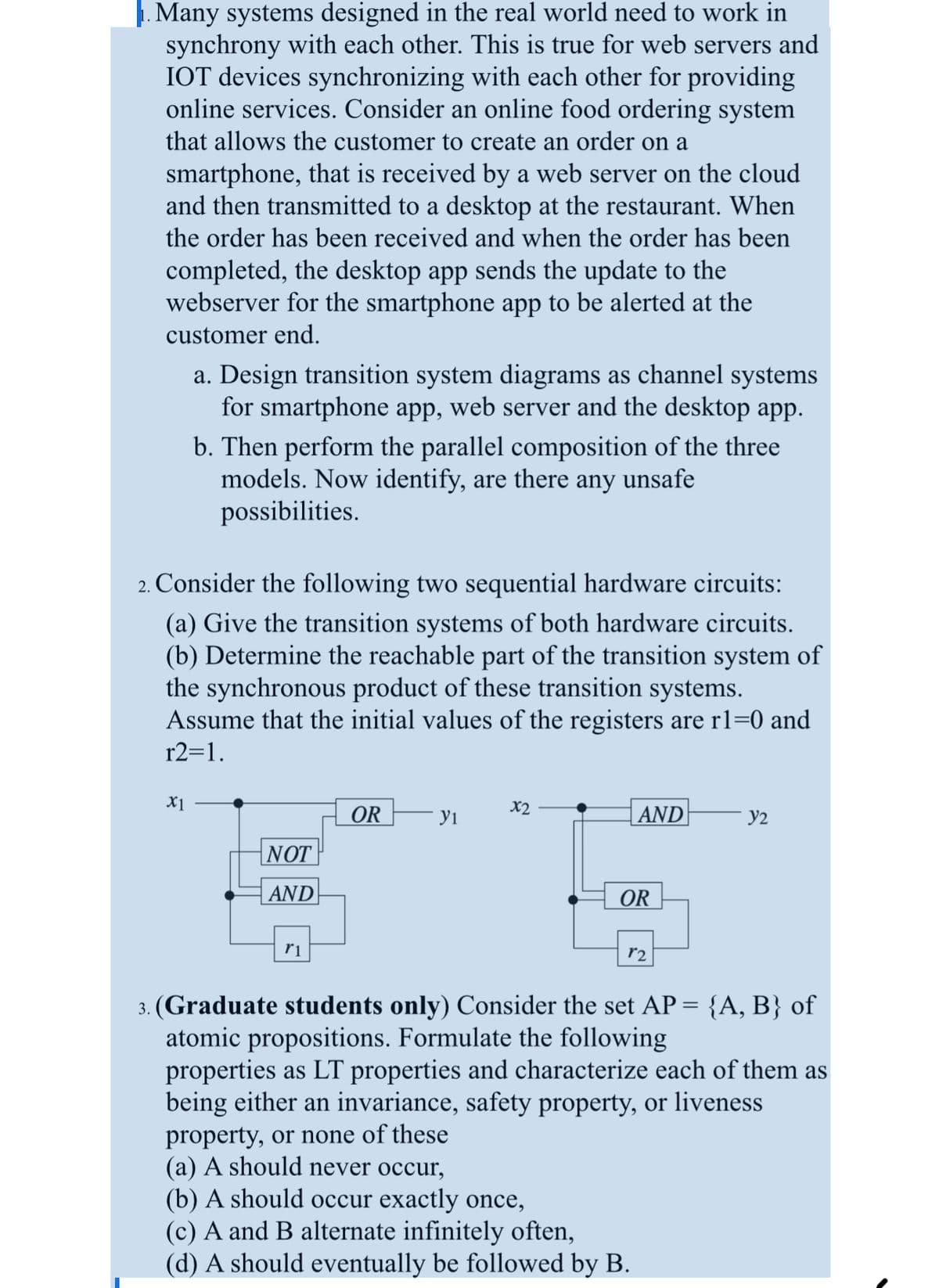1. Many systems designed in the real world need to work in synchrony with each other. This is true for web servers and IOT devices synchronizing with each other for providing online services. Consider an online food ordering system that allows the customer to create an order on a smartphone, that is received by a web server on the cloud and then transmitted to a desktop at the restaurant. When the order has been received and when the order has been completed, the desktop app sends the update to the webserver for the smartphone app to be alerted at the customer end. a. Design transition system diagrams as channel systems for smartphone app, web server and the desktop app. b. Then perform the parallel composition of the three models. Now identify, are there any unsafe possibilities.
1. Many systems designed in the real world need to work in synchrony with each other. This is true for web servers and IOT devices synchronizing with each other for providing online services. Consider an online food ordering system that allows the customer to create an order on a smartphone, that is received by a web server on the cloud and then transmitted to a desktop at the restaurant. When the order has been received and when the order has been completed, the desktop app sends the update to the webserver for the smartphone app to be alerted at the customer end. a. Design transition system diagrams as channel systems for smartphone app, web server and the desktop app. b. Then perform the parallel composition of the three models. Now identify, are there any unsafe possibilities.
Principles of Information Systems (MindTap Course List)
13th Edition
ISBN:9781305971776
Author:Ralph Stair, George Reynolds
Publisher:Ralph Stair, George Reynolds
Chapter4: Software And Mobile Applications
Section: Chapter Questions
Problem 6SAT
Related questions
Question
1. Many systems designed in the real world need to work in synchrony with each other. This is true for web servers and IOT devices synchronizing with each other for providing online services. Consider an online food ordering system that allows the customer to create an order on a smartphone, that is received by a web server on the cloud and then transmitted to a desktop at the restaurant. When the order has been received and when the order has been completed, the desktop app sends the update to the webserver for the smartphone app to be alerted at the customer end.
a. Design transition system diagrams as channel systems for smartphone app, web server and the desktop app.
b. Then perform the parallel composition of the three models. Now identify, are there any unsafe possibilities.
2. Consider the following two sequential hardware circuits:
(a) Give the transition systems of both hardware circuits.
(b) Determine the reachable part of the transition system of the synchronous product of these transition systems. Assume that the initial values of the registers are r1=0 and r2=1.
3. (Graduate students only) Consider the set AP = {A, B} of atomic propositions. Formulate the following
properties as LT properties and characterize each of them as being either an invariance, safety property, or liveness property, or none of these
(a) A should never occur,
(b) A should occur exactly once,
(c) A and B alternate infinitely often,
(d) A should eventually be followed by B.
I have 2question with diagram.
I need all answer please with diagrams

Transcribed Image Text:1. Many systems designed in the real world need to work in
synchrony with each other. This is true for web servers and
IOT devices synchronizing with each other for providing
online services. Consider an online food ordering system
that allows the customer to create an order on a
smartphone, that is received by a web server on the cloud
and then transmitted to a desktop at the restaurant. When
the order has been received and when the order has been
completed, the desktop app sends the update to the
webserver for the smartphone app to be alerted at the
customer end.
a. Design transition system diagrams as channel systems
for smartphone app, web server and the desktop app.
b. Then perform the parallel composition of the three
models. Now identify, are there any unsafe
possibilities.
2. Consider the following two sequential hardware circuits:
(a) Give the transition systems of both hardware circuits.
(b) Determine the reachable part of the transition system of
the synchronous product of these transition systems.
Assume that the initial values of the registers are r1=0 and
r2=1.
X1
NOT
AND
r1
OR
yı
x2
AND
OR
property, or none of these
(a) A should never occur,
(b) A should occur exactly once,
r2
3. (Graduate students only) Consider the set AP = {A, B} of
atomic propositions. Formulate the following
Y2
properties as LT properties and characterize each of them as
being either an invariance, safety property, or liveness
(c) A and B alternate infinitely often,
(d) A should eventually be followed by B.
Expert Solution
This question has been solved!
Explore an expertly crafted, step-by-step solution for a thorough understanding of key concepts.
This is a popular solution!
Trending now
This is a popular solution!
Step by step
Solved in 3 steps

Knowledge Booster
Learn more about
Need a deep-dive on the concept behind this application? Look no further. Learn more about this topic, computer-science and related others by exploring similar questions and additional content below.Recommended textbooks for you

Principles of Information Systems (MindTap Course…
Computer Science
ISBN:
9781305971776
Author:
Ralph Stair, George Reynolds
Publisher:
Cengage Learning

Fundamentals of Information Systems
Computer Science
ISBN:
9781305082168
Author:
Ralph Stair, George Reynolds
Publisher:
Cengage Learning

Systems Architecture
Computer Science
ISBN:
9781305080195
Author:
Stephen D. Burd
Publisher:
Cengage Learning

Principles of Information Systems (MindTap Course…
Computer Science
ISBN:
9781305971776
Author:
Ralph Stair, George Reynolds
Publisher:
Cengage Learning

Fundamentals of Information Systems
Computer Science
ISBN:
9781305082168
Author:
Ralph Stair, George Reynolds
Publisher:
Cengage Learning

Systems Architecture
Computer Science
ISBN:
9781305080195
Author:
Stephen D. Burd
Publisher:
Cengage Learning